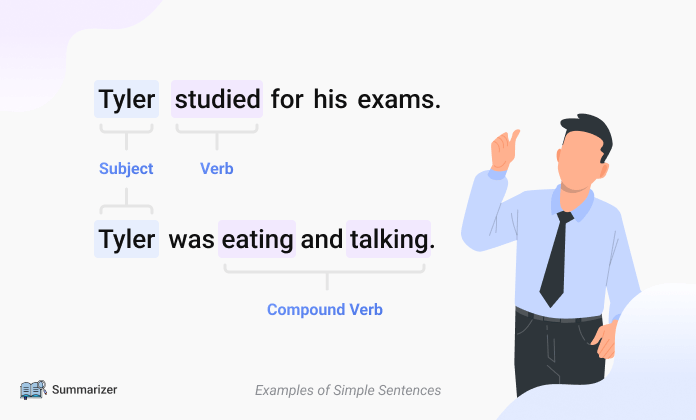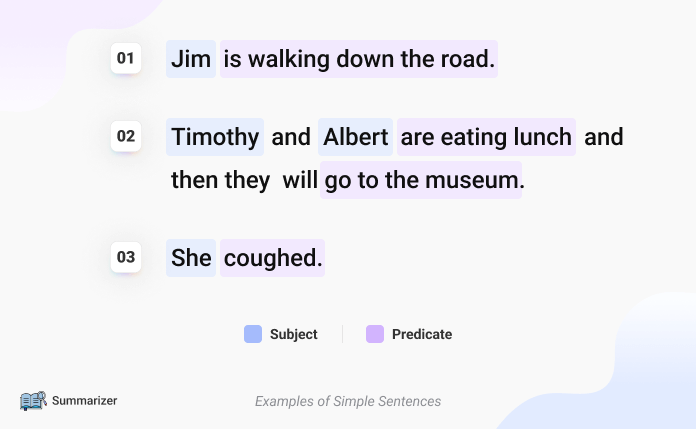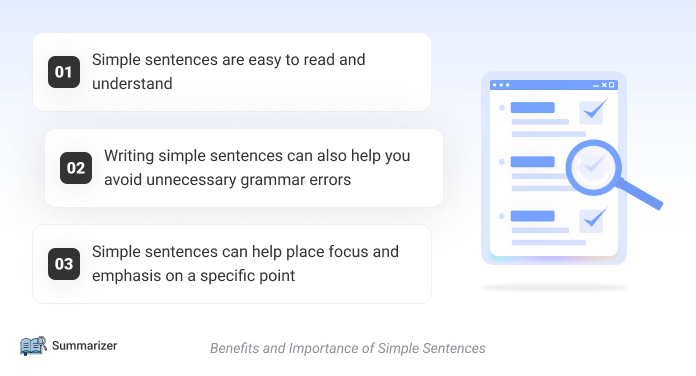What is the difference between a Simple sentence and a Compound sentence?
What are the parts of a Simple sentence?

The simple sentence is an important concept in English grammar. It can be very helpful to know what it exactly is and how it is written. In this post, we’re going to take a look at the definition of simple sentences along with some illustrative examples.
A simple sentence is defined as a sentence that contains one single independent clause consisting of a subject and a predicate. (Learn more about what predicate is by scrolling down to the section dealing with “parts of a simple sentence.”)

Simple sentences can have more than one subject and predicate as well. As long as there is one independent clause in the sentence, it stays within the definition.
The main defining properties of simple sentences can be summarized like this:
Here are some examples of simple sentences.

The difference between a simple sentence is as follows:
In a simple sentence, there is only one independent clause. In a compound sentence, on the other hand, there are two or more independent clauses that are connected by using either a colon (:), semicolon (;), or a coordinating conjunction (for, and, nor, but, or, yet, so).
Some people can also confuse compound sentences and complex sentences. The difference between them is also mentioned below:
In a compound sentence, there are two or more independent clauses connected using a coordinating conjunction. In a complex sentence, however, there is one independent clause and at least one dependent clause that can be connected not only by coordinating conjunctions, but also by correlative conjunctions (such as either/or, rather/than) and subordinating conjunctions (such as before, although, since).
In the table below, we have summarized the main differences between all three of these:
Simple Sentences | Compound Sentences | Complex Sentences |
They contain only one independent clause. | They contain a minimum of two independent clauses. | They contain one independent clause and at least one dependent clause. |
(Since these sentences contain only one independent clause, the matter of connecting clauses doesn’t arise.) | The two independent clauses can only be joined using a coordinating conjunction. (Compound sentences can use other types of conjunctions in the rest of the structure, just not to join the independent clauses.) | The clauses can be joined using all three types of conjunctions (coordinating, correlative, and subordinating). |
Let’s take a more detailed look into the parts of a simple sentence.
In a sentence, the subject refers to the person or object that is performing an action. The subject in a sentence can be a noun, pronoun, or a noun phrase. For example, the word “Jim” in “Jim eats food” is a subject.
You can also read BYJU'S blog for more examples and details about the subject.
There are two different types of subjects in grammar: simple subjects and compound subjects. Both of these subjects can be used in a simple sentence.
The difference between a simple subject and a compound subject is as follows:
A predicate refers to the part of a sentence that describes the action of the subject but not the subject itself. For example, in the sentence, “The brown cat is sitting on the sofa,” the words “sitting on the sofa” make up the predicate because they describe the action of the subject. The words “the” and “brown” aren’t included in the predicate.
This particular example that we’ve mentioned contains a complete predicate. There are different classifications of predicates, which we will explain in the section below:
Here is an explanation of the difference between these three types of predicates.
The following are some points that describe the importance and benefits of simple sentences.

One of the main benefits of simple sentences is that they are readable and easy to comprehend. When the sentence consists of only one independent clause, there are no needlessly complex parts to worry about.
If you are writing content for the general public, such as on a blog or a forum, using simple sentences should be a priority.
By writing simple sentences, you can avoid unnecessary grammar errors. There are many types of errors that arise in only compound and complex sentences, such as the wrong placement of the comma, the incorrect use of a conjunction between clauses, etc. The possibility of such errors does not arise in simple sentences.
If you are writing content and wish to place emphasis on a particular point, using simple sentences can be a great way to do so. When there is just one independent clause, the focus is automatically placed on it. On the other hand, if there are multiple clauses, the sentence becomes long and it is hard to stress a specific aspect.
And there we have it.
Simple sentences can be described as sentences that contain only one independent clause. In the post above, we’ve provided the definition for these sentences along with some examples. We have also elaborated on the different parts they consist of, such as the subject and predicate.
Many people can face trouble differentiating between simple, compound, and complex sentences. We’ve created a table outlining the main differences between them as well.
We hope you learned something new from this blog. Make sure to visit again for some more helpful content.